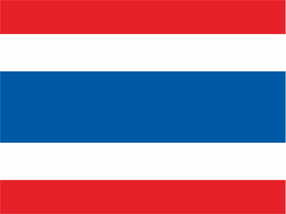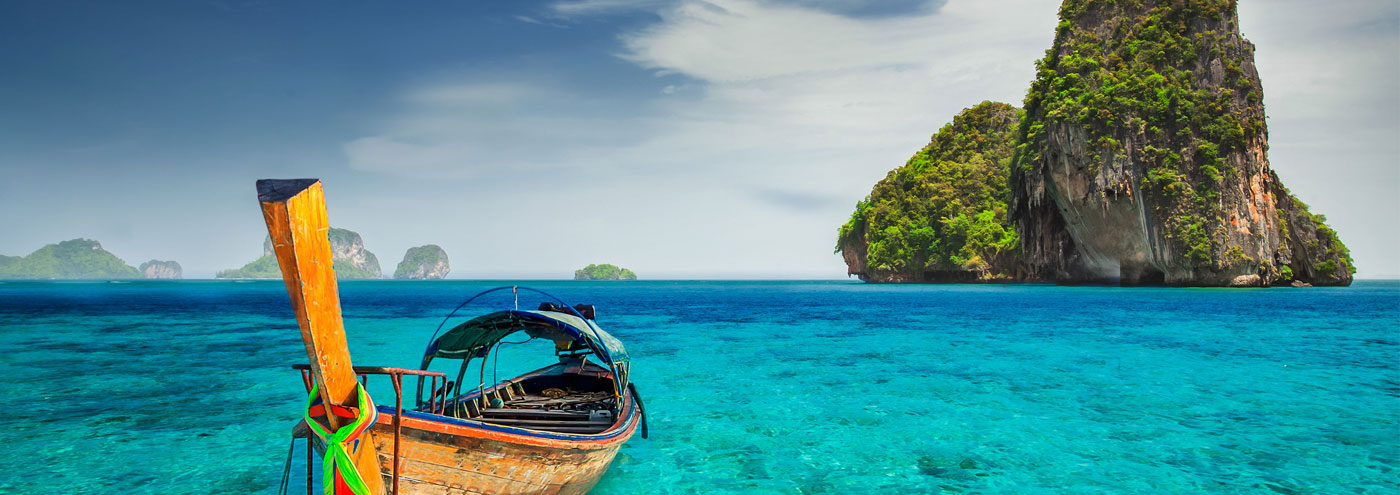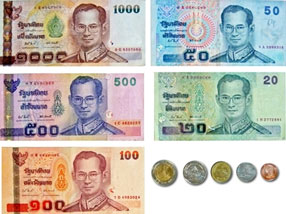

- Flag
- Currency
- Capital
- Climate
- Information



29°C, Wind N at 14 km/h, 60% Humidity
Wat Pho, also known as the Temple of the Reclining Buddha or Wat Phra Chetuphon, is south of the Temple of the Emerald Buddha and the Grand Palace. It is Bangkok's largest temple and contains a huge reclining Buddha figure that is 46 metres (151 ft) long and is covered with gold leaf. The feet alone are 3 metres (10 ft) in size.
Wat Suthat is one of the oldest temples and the site of the Giant Swing, formerly used in an annual Brahman ceremony. A huge teak arch from which the swing was hung still stands in front of the temple.
Wat Saket, or the Golden Mount - houses relics of the Buddha in a 58-metre-high chedi surmounted by a golden cupola. Built by King Rama I just outside the new city's walls, the temple served as the main crematorium. In the century after its construction, some 60,000 plague victims were either cremated there or placed outside for vultures to devour.
Koh Lann - ( Coral Island) offers a change of pace from the busy beaches of Pattaya - an island well known to Thai and foreign visitors for its tranquil surroundings, beautiful beaches, glass-clear waters and extensive coral. This landmass of four square kilometers, just seven kilometers from Pattaya Bay, sports three beaches and is Pattaya’s closest island just a 45-minute boat ride from shore.
Koh Lann is a lovely spot catering to all kinds of tourists. Whether you want to laze around on the island’s soft, white sand, or get more lively and play a few water sports is up to you. The island offers parasailing, water-skiing and jetskis. Snorkeling and deep-sea diving are recommended off the nearby islands of Koh Krok and Koh Sak, where there is an abundance of coral and undersea life waiting to be discovered. However, tourists should bring their own diving equipment since there are no dive shops in this area.
Gems Gallery is situated in four major cities, Bangkok, Chiangmai, Phuket and Pattaya. Each branch is in itself a top tourist destination, and all make it easier for visitors to choose and own beautiful gems. No matter which branch you visit, you can be sure that you will get only the best in products and services.
Nong Nooch - tropical garden close to Pattaya is the largest botanical garden in South East Asia. The vast gardens are set in an area of around 600 acres, that originally was to be used as a plantation to grow local fruits.The area was then first turned into a garden for conservation of certain species of plants and flowers, and was later opened to visitors.In the gardens you will find an enormous number of plant and flower species in a particularly well kept environment.
The Phi Phi islands are some of the loveliest in Southeast Asia. Just a 45-minute speedboat trip or a 90-minute ferryboat ride from either Phuket or Krabi, these picture postcard islands offer the ultimate tropical getaway. Featuring classic tropical beaches, stunning rock formations and vivid turquoise waters teeming with colourful marine life, it is paradise perfected. Phi Phi is a group of six islands. The two main islands are Phi Phi Don and Phi Phi Leh. The larger and inhabited Phi Phi Don attracts hundreds of visitors to stay on its lovely shores while the smaller uninhabited Phi Phi Leh hosts stunningly beautiful bays and beaches, including the world-famous Maya Bay, which was the set where The Beach (with Leonardo Di Caprio) was filmed.
Four Island Tour (Ao Nang), taking in the group of islands closest to the coast – the ones that can be seen on the horizon from the beach. The four islands are Koh Poda, Koh Gai (Chicken Island), Koh Tub and Koh Mor; and the tour also stops off at the beautiful Phra Nang Cave Beach on the Railay peninsula. This beach, inaccessible by road, is considered to be one of the most beautiful strips of sand in the world.Koh Poda is famous for its white beaches and turquoise water; the huge rock in front of it (pictured above) has been featured on countless postcards, screeensavers and tourist brochures, so don’t miss the opportunity to snap your own photo memory here. The cruise around the “head” of Chicken Island, with the odd rocky outcrop that earned it its name also makes a good photo op. Fun fact: Chicken Island is really called “Axe Island” or Koh Hua Gwan; it was dubbed “that chicken island” by Krabi’s first tourists and the nickname stuck. At low tide, the boat will stop between Chicken Island with the two tiny islands of Koh Mor and Koh Tub, where you will have the opportunity to walk along the sweeping three-pronged sandbar that links the three together.There will also be a couple of stops at open water snorkeling sites, which could be near Koh Yawasam, a rocky outcrop with fairly intact coral reefs and decent marine life, or at the rear of Chicken Island, depending on the day. Snorkeling here is average due to years of heavy boat traffic. Itinerary order varies throughout the month, so that the sandbar can be reached at low tide (at high tide it is barely visible) and will include a picnic lunch (or BBQ dinner) on one of the islands or beaches.
